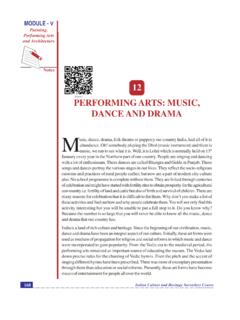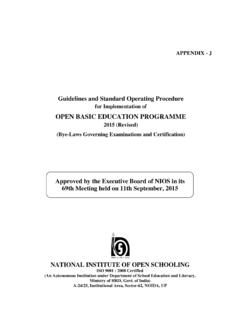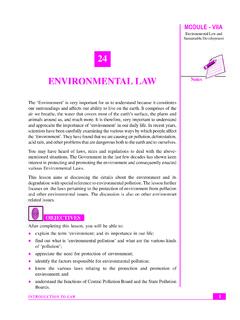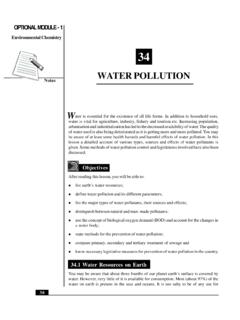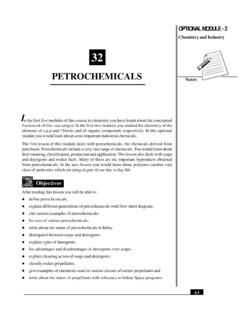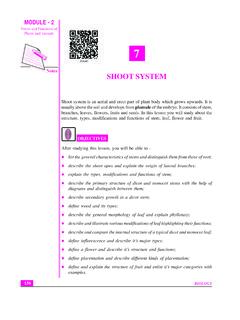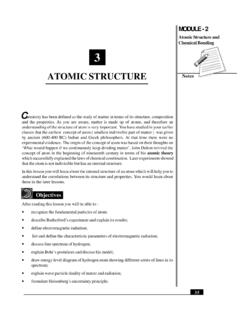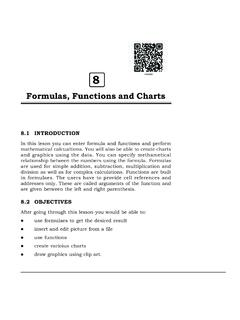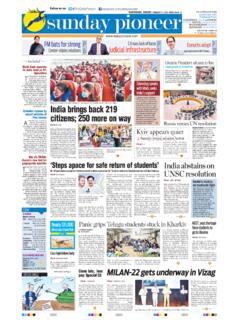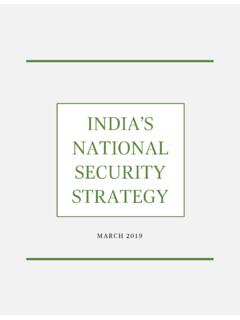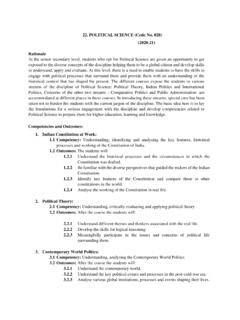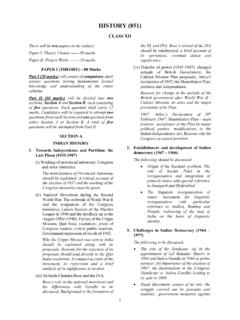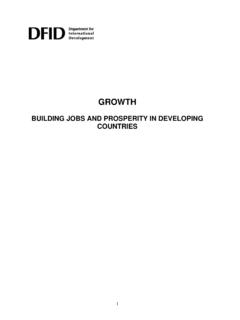Transcription of MODULE 2 MEDIEVAL INDIA - National Institute of Open …
1 MODULE 2 MEDIEVAL INDIALESSON 9 ESTABLISHMENT AND EXPANSION OF THEDELHI SULTANATELESSON 10 ESTABLISHMENT OF THE MUGHAL RULELESSON 11 EMERGENCE OF REGIONAL STATES IN INDIA :TWELFTH TO EIGHTEENTH CENTURYLESSON 12 ADMINISTRATIVE SYSTEM AND INSTITUTIONSLESSON 13 ECONOMYLESSON 14 CULTURAL DEVELOPMENTS IN MEDIEVALINDIALESSON 15 UNDERSTANDING EIGHTEENTH CENTURYINDIAHISTORY133 MODULE - 2 MEDIEVAL IndiaESTABLISHMENT AND EXPANSIONOF THE DELHI SULTANATE9 NotesThe rulers who ruled substantial parts of the North INDIA between AD1200 to AD1526were termed as Sultans and the period of their rule as the Delhi Sultanate. Theserulers were of Turkish and Afghan origin. They established their rule in INDIA afterdefeating the Indian ruling dynasties which were mainly Rajputs in northern main ruler who was overthrown by the invading Turk Muhammad Ghori fromDelhi was Prithvi Raj Chauhan.
2 These Sultans ruled for more than 300 years (fromaround AD 1200 to AD 1526). The last of the Delhi Sultan, Ibrahim Lodi was de-feated by the Mughals under the leadership of Babur in AD1526 who established theMughal Empire in this period of around three hundred years five different dynasties ruled were the Mamluks (AD 1206 AD 1290) (popularly known as slave dynasty),the Khaljis (AD 1290 AD 1320), the Tughlaqs (AD 1320 AD 1412), the Sayyids(AD 1412 AD 1451) and the Lodis (AD 1451 AD 1526). All these dynasties arecollectively referred as the Delhi this lesson we will give you a detailed account of the process of conquest, expan-sion and consolidation of Delhi Sultanate in studying this lesson you will be able to: describe the early invasion on INDIA from the North-West region by the Arabs discuss the nature of attacks by Mahmud Ghazni describe the nature of Muhammad Ghori s invasion identify the factors that helped the establishment of Turkish rule in North Indiaby Muhammad Ghori provide an account of the expansion of Delhi Sultanate under the Mamluk sul-tans describe the expansion of the Sultanate by Khaljis and Tughlaqs outline the challenges faced by the Sultans in consolidating their rule list the causes of the decline of the - 2 MEDIEVAL IndiaNotes Establishment and Expansion of the Delhi arab INVASION OF INDIAIn the early 8th century Arabs invaded INDIA from the North-West region.
3 This Arabinvasion in AD 712 was led by Muhammad Bin Qasim a general of the Umayyad caliph-ate. Invasion on INDIA was part of the policy of arab expansion during this rise of Islam in Arabia (see box) gave rise to a new political system. The processof expansion which had started after the capture of Mecca by the prophet Muhammadcontinued after his And Spread Of IslamIn the 7thCentury AD, a new religion named ISLAM was born in Arabia and ina very short span it carved out an empire extending from North Africa to IberianPeninsula to Iran and INDIA . Islam was founded and preached by ProphetMuhammad (AD 570 632). This religion transformed the religious, political andsocial life of not only the people of Arabia but also of many parts of the laid emphasis upon belief in one God and its holy book as the QURAN.
4 Muslims believe that the Quran is revealed by God to Prophet Muhammad. Quranis respected as the supreme source of authority in Islam. Every Muslim was askedto pray five times a day, to fast during the month of Ramzan, to distribute alms andto make a pilgrimage, if possible, to Mecca. After the death of Prophet (AD 632)the task of providing religious and political leadership to the Muslims passed on tothe Caliphs. (Caliph is derived from the Arabic word Khalifa which means deputy . This is a title given to the rulers who succeeded Prophet Muhammad).Between AD 632 661 there were four pious Caliphs, all close companions of theProphet. The Umayyad Caliphate (AD 661 750) succeeded the pious dynasty gave stability and prosperity to the Caliphate. Umayyad dy-nasty was followed by the Abbasid Caliphate (AD 750 1258).
5 During the time oflater Abbasids, the Caliphs began to loose political control and independent MuslimRulers (Sultans) emerged in several arab expansion was notable for the speed with which it was accomplished. BetweenAD 633 637, arab conquered West Asia, Jordan Syria, Iraq, Turkey and Persia. Theyalso conquered parts of North Africa and Southern Europe. Between AD 639 637, Egyptwas also conquered. By AD 712, the Arabs had entered Spain and were soon makinginroads into Southern France. By the 8th Century AD, the Arabs had acquired a coreposition from Spain to INDIA , connecting the trade of Mediterranean and the Indian the early years of the 8th Century, the Umayyads reached the height of theirpower. They had created the largest ever-Mulsim state that existed. Arabs were alsoattracted by the wealth of INDIA .
6 arab merchants and sailors had brought back stories ofgreat wealth of INDIA . However, the reason for the invasion of Sindh was to avenge theplunder of arab Ships by pirates of Debol. King Dahir refused to punish the the governor of Iraq despatched an army under Muhammad Bin Qasim. Hearrived in Sind in AD 712, and besieged Debol which was situated on the sea crossing the Indus he marched forward. At Rawar, Muhammad Bin Qasim at-tacked Dahir who was defeated. Arabs killed a large number of fleeing soldiers. Dahirwas also caught and killed. Muhammad Bin Qasim now proceeded forward and withina short span he conquered various important places in Sind including - 2 MEDIEVAL IndiaNotesHISTORY Establishment and Expansion of the Delhi sultanateThe economic life of Sind got disturbed as a result of campaigns of Qasim.
7 A large numberof people and merchants had fled from Sind. He had conquered the major portion of Sind upto the lower Punjab. His rule lasted only for two years. However many Arabs settled downin Sind and established relations with the local population. The arab influence continued fora long period with pockets of Muslim influence established in various parts of MAHMUD GHAZNIIn all Mahmud Ghazni invaded INDIA 17 times during AD 1000 1026. Mahmud Ghazniwas Son of Sabuktigin, the founder of Ghazni dynasty & Turkish slave Ghazni first encountered the Hindushai ruler, Jaipal in AD 1001. In theyears AD 1004 06 Mahmud Ghazni attacked the rulers of Multan. Soon Punjab alsopassed into the hands of the Ghaznavids. Between AD 1014 1019, Mahmud en-riched his treasury by looting the temples of Nagarkot, Thanesar, Mathura and attack against Nagarkot in AD 1008 has been described as his first great tri-umph.
8 In AD 1025, Mahmud embarked on the most ambitious Indian campaign, theattack on the Somnath temple in Saurashtra. Mahmud captured the city after grimstruggle in which more than 50,000 defenders lost their lives. Mahmud left Somnathafter a fortnight when he came to know that the Gujarat king Bhima-I had completedpreparations to confront him. His attacks on INDIA were an attempt to fulfil his ambi-tion to make Ghazni the formidable power in the politics of Central Asia. Mahmud sraids into INDIA were only to acquire the famous wealth of INDIA . This wealth wouldhelp him to consolidate his vast rule in Central Asia. He did not wish to establish anempire in INDIA . The Ghaznavids had their control on parts of Punjab and Sind whichcontinued till AD 1135. However his invasions exposed the weak defence of Indiankingdoms.
9 They also opened possibility of attacks in future by the MUHAMMAD GHORI (SHAHABUDDIN MUHAMMAD)In AD 1173 Shahabuddin Muhammad (AD 1173 1206) also called Muhammad of Ghorascended the throne of Ghazni. The Ghoris were not strong enough to meet the growingpower and strength of the Khwarizmi Empire; they realised that they could gain nothing inCentral Asia. This forced Ghori to turn towards INDIA to fulfil his expansionist Ghori was very much interested in establishing permanent empire inIndia and not merely looting its wealth. His campaigns were well organised andwhenever he conquered any territory, he left a general behind to govern it in hisabsence. His invasions resulted in the permanent establishment of the Turkish Sul-tanate in the region lying north of the Vindhya of Punjab and SindMuhammad Ghori led his first expedition in AD 1175.
10 He marched against Multanand freed it from its ruler. In the same campaign he captured Uchch from the BhattiRajputs. Three years later in AD 1178 he again marched to conquer Gujarat but theChalukya ruler of Gujarat, Ghima II defeated him at the battle of Anhilwara. But thisdefeat did not discourage Muhammad Ghori. He realised the necessity of creating asuitable base in Punjab before venturing on the further conquest of launched a campaign against the Ghaznavid possessions in Punjab. As a resultPeshawar was conquered in AD 1179 80 and Lahore in AD 1186. The fort of Sialkotand Debol were captured next. Thus by AD 1190 having secured Multan, Sind and Punjab,Muhammad Ghori had paved the way for a further thrust into the Gangetic - 2 MEDIEVAL IndiaNotes Establishment and Expansion of the Delhi sultanateThe First Battle of Tarain (AD 1191)Muhammad Ghori s possession of Punjab and his attempt to advance into the GangeticDoab brought him into direct conflict with the Rajput ruler Prithivaraja Chauhan.
